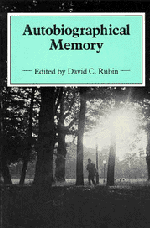Book contents
- Frontmatter
- Contents
- List of contributors
- Preface
- Part I Overview
- Part II Historical, theoretical, and methodological contexts for the study of autobiographical memory
- Part III The general organization of autobiographical memory
- 5 Nested structure in autobiographical memory
- 6 Schematization of autobiographical memory
- 7 Strategic memory search processes
- 8 Autobiographical memory: a developmental perspective
- Part IV The temporal organization of autobiographical memory
- Part V Temporal distributions of autobiographical memories
- Part VI Failures of autobiographical memory
- Author index
- Subject index
7 - Strategic memory search processes
Published online by Cambridge University Press: 01 March 2011
- Frontmatter
- Contents
- List of contributors
- Preface
- Part I Overview
- Part II Historical, theoretical, and methodological contexts for the study of autobiographical memory
- Part III The general organization of autobiographical memory
- 5 Nested structure in autobiographical memory
- 6 Schematization of autobiographical memory
- 7 Strategic memory search processes
- 8 Autobiographical memory: a developmental perspective
- Part IV The temporal organization of autobiographical memory
- Part V Temporal distributions of autobiographical memories
- Part VI Failures of autobiographical memory
- Author index
- Subject index
Summary
Remembering experiences from one's own past is a central cognitive process that is a component in the performance of many behaviors. Much of conversation, for example, consists of two parties conveying experiences relevant to their topic of discussion. Comprehension not only relies on generalizations that have been learned about the world but often entails accessing individual experiences in order to make sense of a story or a real-world event (Schank, 1982). Furthermore, planning actions in order to solve problems often requires accessing past experiences along with general knowledge (Carbonell, 1982; Kolodner, 1983a; Ross, 1984).
Consider, however, the difficulty of retrieving particular individual experiences from memory. This type of retrieval typically involves searching through an enormous data base of stored experiences using an ill-specified description of the experience (or type of experience) targeted for retrieval. To date, most studies of memory have largely addressed the architecture of the memory system. Most memory models, for example, have focused on structural factors affecting the retrieval and accessibility of items in memory, such as the frequency of a target item, the discriminability of targets, the recency of encoding the item, and the strength of associations connecting items. Yet, as memory researchers now turn to studies of more natural and complex retrieval phenomena such as memory for real-world events, characterizations of the architecture of the memory system are unlikely to be sufficient (Neisser, 1978; Reiser, in press).
- Type
- Chapter
- Information
- Autobiographical Memory , pp. 100 - 121Publisher: Cambridge University PressPrint publication year: 1986
- 25
- Cited by



